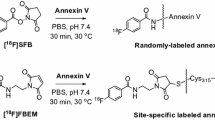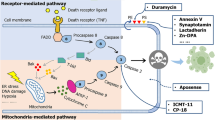Abstract.
Either inadequate or excessive apoptosis (programmed cell death) is associated with many diseases. A method to image apoptosis in vivo, rather than requiring histologic evaluation of tissue, could assist with therapeutic decision making in these disorders. Programmed cell death is associated with a well-choreographed series of events resulting in the cessation of normal cell function, and the ultimate disappearance of the cell. One component of apoptosis is signaling adjacent cells that this cell is committing suicide by externalizing phosphatidylserine to the outer leaflet of the cell membrane. Annexin V, a 32-kDa endogenous human protein, has a high affinity for membrane-bound phosphatidylserine. We have coupled annexin V with the bifunctional hydrazinonicotinamide reagent (HYNIC) to prepare technetium-99m HYNIC-annexin V and demonstrated localization of radioactivity in tissues undergoing apoptosis in vivo. In this report we describe the results of a series of experiments in mice and rats to characterize the biologic behavior of 99mTc-HYNIC- annexin V. Biodistribution studies were performed in groups of rats at 10–180 min after intravenous injection of 99mTc-HYNIC-annexin V. In order to estimate the degree of apoptosis required for localization of 99mTc-annexin V in vivo, mice were treated with dexamethasone at doses ranging from 1 to 20 mg/kg, 5 h prior to 99mTc-HYNIC-annexin V administration, to induce thymic apoptosis. Thymus was excised 1 h after radiolabeled HYNIC-annexin V injection; thymocytes were isolated, incubated with Hoechst 33342 followed by propidium iodide, and analyzed on a fluorescence-activated cell sorter. Each sorted cell population was counted in a scintillation counter. To test 99mTc-HYNIC-annexin V as a tracer for external radionuclide imaging of apoptotic cell death, radionuclide imaging of Fas-defective mice (lpr/lpr mice) and wild-type mice treated with the antibody to Fas (anti-Fas) was carried out 1 h post injection. Rat biodistribution studies demonstrated a blood clearance half-time of less than 10 min for 99mTc-HYNIC-annexin V. The kidneys had the highest concentration of radioactivity at all time points. Studies in the mouse thymus demonstrated a 40-fold increase in 99mTc-HYNIC-annexin V concentration in apoptotic thymocytes compared with the viable cell population. A correlation of r=0.78 was found between radioactivity and flow cytometric and histologic evidence of apoptosis. Imaging studies in the lpr/lpr and wild-type mice showed a substantial increase of activity in the liver of wild-type mice treated with anti-Fas, while there was no significant change, irrespective of anti-Fas administration, in lpr/lpr mice. Excellent images of hepatic apoptosis were obtained in wild-type mice 30 min after injection of 99mTc-HYNIC-annexin V. The imaging results were consistent with histologic analysis in these animals. In conlusion, these studies confirm the value of 99mTc-HYNIC-annexin V uptake as a marker for the detection and quantification of apoptotic cells in vivo.
Similar content being viewed by others
Author information
Authors and Affiliations
Additional information
Received 22 February and in revised from 5 May 1999
Rights and permissions
About this article
Cite this article
Ohtsuki, K., Akashi, K., Aoka, Y. et al. Technetium-99m HYNIC-annexin V: a potential radiopharmaceutical for the in-vivo detection of apoptosis. Eur J Nucl Med 26, 1251–1258 (1999). https://doi.org/10.1007/s002590050580
Issue Date:
DOI: https://doi.org/10.1007/s002590050580




